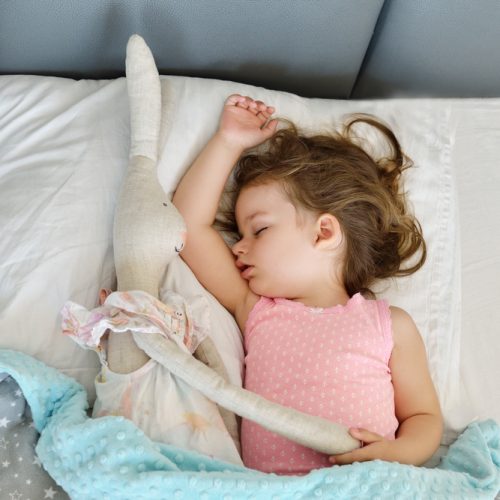The main takeaways for this guide take two minutes to read. It contains information from ten sources, including the American Academy of Pediatrics and Zero to Three Foundation. See the full list below.
This guide will be updated again in September 2021. Know something we should add? Email us.
There isn’t an official position on when *toddlers and preschoolers* should be sleeping in their own bed and not with their parents. (The American Academy of Pediatrics is, however, very clear about not co-sleeping with infants.) That means recommendations do vary, but we are boiling down what we saw as most common from ten expert sources, including the American Academy of Pediatrics and the Child Mind Institute.
The Less Than Two Minutes Version: Getting Your Toddler To Sleep In Their Bed
- Most pediatricians and psychologist sources recommended having children sleep in their own bed once they can escape from a crib, in order to…
- Help children develop the skill to calm themselves down when they are alone and not rely on their parents to reduce their anxiety at night.
- Help parents (and kids!) get more regular sleep.
- Help children develop the skill to calm themselves down when they are alone and not rely on their parents to reduce their anxiety at night.
- Less frequent but noted by a few pediatricians and psychologists: Sleep arrangements are about what makes your family happy – if you and your partner aren’t getting sleep because of children interrupting your sleep, it might be time to change. If its working for everyone, then you don’t need to change.
- If you have a child that keeps coming into your bed and you want them to stop, the most common method was “fading.” There are a lot of different variations on this, but the overall process broke down to the steps below. (And we cover lots of different versions here.)
- Tell your kid why — at this stage, having an explanation can help! (And saying you need more sleep or that they need to learn to sleep without you are both good reasons.)
- Start with them going to sleep in their bed and you laying down next to them, or if you can get away with it, in a chair as they fall asleep.
- Try to not pay attention to them as they fall asleep. Leave when they are actually asleep.
- Make any nighttime wake-up as boring and unexciting as possible. Calmly walk them back to their room and put them back in bed.
- Over the next few nights, move from sitting in their room as they fall asleep to the hallway or somewhere further away.
- Tell your kid why — at this stage, having an explanation can help! (And saying you need more sleep or that they need to learn to sleep without you are both good reasons.)
- Even if this has been going on for awhile, several psychologists said parents can change this behavior, but it can take several weeks or longer for some kids.

The Longer Version: This Is Normal + Variations on “Fading”
This is Normal. And Many Sources Say It’s Part of Teaching Your Child Self-Soothing Skills.
The Zero to Three Foundation says toddlers getting out of their beds is very normal, as your child is “determined to exercise their newfound freedom and prolong their daytime fun.” They also point out that it is very common for people of all ages to wake up at night, and because your child’s new bed setup is new and unfamiliar (i.e. a new view or sheets and blankets), they come seeking comfort.
They also caution that this is a learning curve for both child and parent: Like so many parts of being a parent, this means having to establish new bedtime rules. Their advice is “sensitivity and consistency,” or in other words, letting your child know that you know this is a big change, but adhering to the rule of sleeping in your own bed.
The American Academy of Pediatrics echoes this, saying that toddler’s may have a “heady sense of freedom” after their transition to a bed, but “most children are happy to ‘graduate’ and stay in their beds.” But they also add for a few the transition is more difficult, and the best way to continue is to continue the regular bedtime routine and use the “fading” method (described more below.)
Jamie Howard, a senior clinical psychologist at the Child Mind Institute specializing in anxiety disorders, explains that letting your children habitually sleep in your room can be “inadvertently confirming [their] notion that it’s unsafe to be alone.” Howard adds that a lot of well-intentioned parents accidentally reinforce anxiety when their kids come to them for reassurance, but its never too late to start teaching your child those skills.
But Others Say There Is No “Right Way” For Toddlers to Sleep
There were two sources we found that emphasized that there is no “right way” for toddler sleeping. Steven Dickstein, a pediatrician at the Child Mind Institute, wrote that “having a child come into your bed to sleep isn’t, in itself, problematic, but it can certainly be stressful if it’s interfering with sleep (his or yours) or creating conflict in the family.” He said there is “no one ‘right’ way for a child to sleep — except that everyone in the family has to get enough sleep.”
And Doug Teti, a professor of human development at Penn State, found in one study that co-sleeping with toddlers was associated with more stress, especially for mothers. Teti co-slept with his children, and as the New York Times put it, he emphasized “that the research isn’t an indictment against co-sleeping, but does suggest that a number of factors, including cultural pressures and an unsupportive spouse, can make longer-term co-sleeping a more stressful experience for some families.”
Fading: How to Get Your Kid Out of Your Bed
There are a lot of variations on exactly how to do this. Below we’ve rounded up a few of the best explanations we saw.
Psychologist Lynelle Schneeberg breaks down the process for especially persistent co-sleepers into essentially four steps:
- Have a temporary bed/sleeping bag in your child’s room (or sleep in their bed) so they learn that it is normal and safe to wake up in their own room in the morning.
- After some time, transition to a chair as they fall asleep, and move to your own room after that. If that results in many nighttime wake-ups, go back to step one to avoid losing a lot of sleep yourself.
- If they wake up in the middle of the night, walk them back to their room, tuck them in, but make it as un-exciting as possible. No stories, snacks, or anything else that will teach your child that this is a time where they can have something fun happen.
- If you have tried all of the above for some time and your child is extra persistent about wanting to come in your room, build them a “nest” in your own room, i.e. a space that is designated for them to sleep in at night that is not your bed. She suggests having a rule that they go in and sleep in that spot quietly without waking you up.
Schneeberg also emphasizes that once your child is able to fall asleep without you being there, it will be far easier to get them to sleep in their own room through the night.
The American Academy of Pediatrics recommends a similar approach, which is basically to calmly and quietly walk your child back to their bed if they wake up and come find you. They also emphasize making this a brief, not-exciting interaction, and to be prepared to have to repeat these steps (and note that as many as 20 “farewell appearances” in one night at the beginning of the new bed transition isn’t unusual.) And they also caution against making anything about leaving their bed seem like a reward (and that includes negative attention.)
Steven Dickstein at the Child Mind Institute explains his typical recommendations this way:
- It is normal for children to wake up in the middle of the night. For them to stay in their room through the night, they have to be able to fall asleep on their own.
- If your child is relying on you being there to fall asleep, withdraw gradually before they actually fall asleep.
- You can do that by moving a little further away each night, for example from their bed to a chair in the room to down the hall.
And also from the Child Mind Institute, psychologist Jamie Howard recommends this process below for fading. In particularly tough cases, she says it can take months to work:
- If your child is old enough to articulate why they are coming to you at night, ask them. It can help clarify exactly what might be making them anxious at night. She emphasizes that it’s important not to shame your child for their fears.
- At night, start with your child in their bed and you sitting in a chair until they fall asleep.
- Once your child is able to fall asleep that way, start moving the chair further and further away until you are outside the bedroom with the door open.
- If your child gets into bed with you at any point, get up and calmly walk them back to their room.
- Your child sleeping in their own bed needs to be regularly enforced, because “letting [them] backtrack really mars the progress [they are] making.”
Sources
AAP Supports Childhood Sleep Guidelines – HealthyChildren.org
Big Kid Beds: When to Make the Switch – HealthyChildren.org
How do I get my son to sleep in his own bed? | Child Mind Institute
How Should I Deal With My Child’s Night Wakings? | Psychology Today
My Child Won’t Stay In Her Bed • ZERO TO THREE
Smart Solutions for Safe and Sound Sleep – YouTube
The Impact of Chronic Co-Sleeping With an Older Child | Psychology Today
When Kids Are in the Bed: The Ups and Downs of Co-Sleeping – The New York Times (nytimes.com)


